Advanced HVAC Control Systems Market Research: 2032
The Global Advanced HVAC Control Systems Market Size was valued at $3.1 billion in 2022, and is projected to reach $6.8 billion by 2032, growing at a CAGR of 8.3% from 2023 to 2032. Advanced HVAC control systems automatically adjust the operation of HVAC systems. Advanced controls are equipped with sensors that detect the environmental conditions and a microprocessor gives commands to the HVAC components based on predefined instructions or as directed by the inbuilt artificial intelligence (AI) in a few types of control systems.
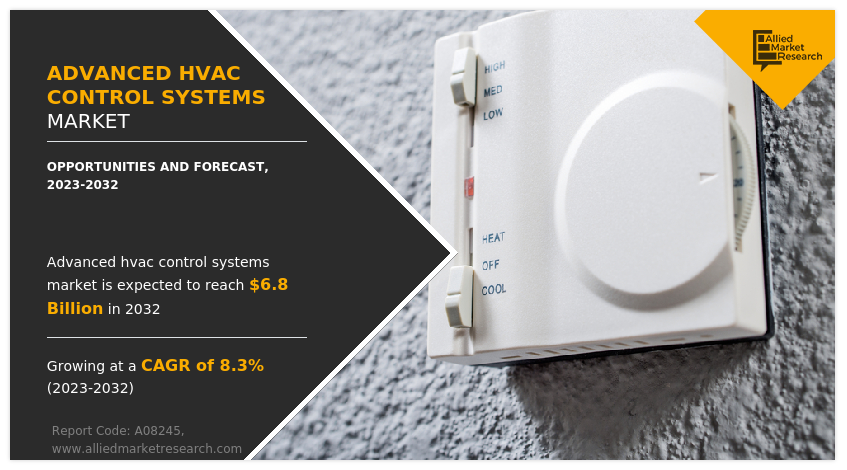
Market Dynamics
By the end of the last century, the pace of global population growth has increased significantly, eventually driving the demand for energy. For example, from 1971 to 2019, a substantial increase in the world's total energy consumption has been witnessed, with fossil fuels contributing to over 80% of the total supply. Among the major electricity consumers, the building sector is responsible for about 55% of global electricity consumption. In addition, among the various components within buildings, heating, ventilation, and air conditioning (HVAC) systems emerge as major electricity consumers, utilizing approximately 40% of the total electricity. Furthermore, in the past few years, the trend of sustainable development has witnessed significant popularity among the masses, which in turn has propelled the demand for advanced HVAC control systems as these systems assist in saving substantially electric energy. Studies conducted independently suggest that these systems can lead to substantial electricity savings, ranging from 20% to 30%.
The primary reason for the high efficiency of advanced HVAC control systems lies in their automation capabilities. For example, these systems can dynamically adjust HVAC settings to the lowest power consumption or activate sleep mode when a room is unoccupied. In addition, advanced HVAC control systems can respond to environmental factors such as occupancy levels, humidity, and air quality, automatically adapting HVAC operation settings. This level of automation ensures optimal energy utilization, contributing to electricity savings. Such benefits of advanced HVAC control systems not only lead to substantial electricity savings but also contribute to a greener and more sustainable environment.
In addition, the market for advanced HVAC control systems is also driven by incrased adoption of building automation systems (BAS) across the world, especially in developing countries. For example, 60% of commercial buildings larger than 50,000 sq.ft have BAS to control HVAC systems as well as other necessary systems in a building. However, only 13% of buildings smaller than 50,000 sq.ft use BAS for HVAC control, indicating a high potential for the uptake of advanced HVAC control systems in the left-out buildings. Furthermore, there has been a significant rise in the adoption of BAS in office buildings and large shopping complexes, and other commercial buildings in developing countries. The rise in disposable income of a considerable population in developing nations is propelling the adoption of BAS in residential application, eventually having a positive impact on the advanced HVAC control systems market outlook.
However, the high upfront cost of advanced HVAC control systems discourages the building owners from opting these advanced solutions. Advanced HVAC control systems are commonly equipped with technologies such as IoT, AI, and other advanced features which are still not very common in various parts of the world. Thus, equipment with these technologies are expensive. For example, a programable thermostat costs $25 to $75; however, a smart thermostat costs between $100 and $200. Thus, such high costs are expected to hinder the advanced HVAC control systems market growth.
Moreover, technological advancements, including the integration of IoT and AI, have helped in making user-friendly methods for managing and controlling HVAC systems. Notably, smartphone apps make significant use of these technologies to offer convenient control. Apps like LG ThinQ App and airCloud Go, both from OEMs and third-party providers, are gaining traction in the market. In addition, the emergence of smart IoT devices such as Alexa and Google Home provides new ways of HVAC control. Such developments, which are simplifying HVAC control and making it accessible remotely, present growth opportunities for businesses in the advanced HVAC control systems market.
The advanced HVAC control systems market witnesses various obstructions in its regular operations due to the COVID-19 pandemic and inflation. Earlier, the global lockdowns resulted in reduced industrial activities, eventually leading to reduced demand for advanced HVAC control systems from construction and industrial sectors. However, COVID-19 has subsided, and the major manufacturers in 2023 are performing well. Contrarily, the rise in global inflation is a new major obstructing factor for the entire industry. The inflation, which is a direct result of the Ukraine-Russia war and few long-term impacts of the coronavirus pandemic, has introduced volatility in the prices of raw materials used for construction which is a major end-user sector of HVAC systems. In addition, inflation is expected to worsen in the coming years, as the possibility of the ending of the war between Ukraine and Russia is less. However, a peace agreement between Ukraine and Russia can be devised, with the continued talks between different countries, which is expected to end the war between them and reduce global inflation.
Segmental Overview
The advanced HVAC control systems market is segmented on the basis of installation type, system, application, and region. By installation type, the market is divided into new installation, and retrofit. By system, the market is categorized into temperature control system, ventilation control system, humidity control system, and integrated control system. By application, the market is divided into residential, commercial, and industrial. Region-wise, the market is analyzed across North America (U.S., Canada, and Mexico), Europe (Germany, France, Italy, UK, and rest of Europe), Asia-Pacific (China, India, Japan, South Korea, and rest of Asia-Pacific), and LAMEA (Latin America, Middle East, and Africa).
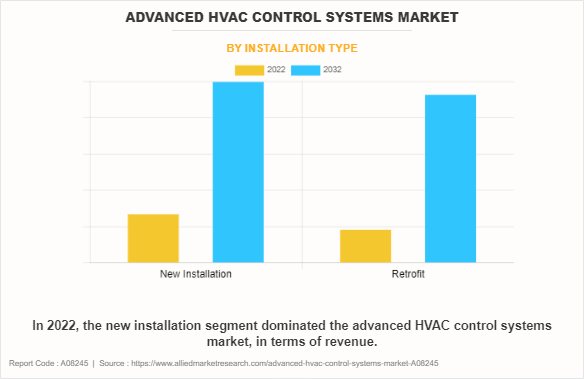
By Installation Type:
The advanced HVAC control systems market is divided into new installation and retrofit. In 2022, the new installation segment dominated the advanced HVAC control systems market share, in terms of revenue, and the retrofit segment is expected to grow with a higher CAGR during the forecast period. Rapid ongoing construction of buildings across the world especially in the developing nations is a major factor that dominates the growth of the new construction segment. However, with rise in concerns over environment degradation, the retrofits of new energy-saving components including advanced HVAC control systems is growing with a higher CAGR during the forecast period.
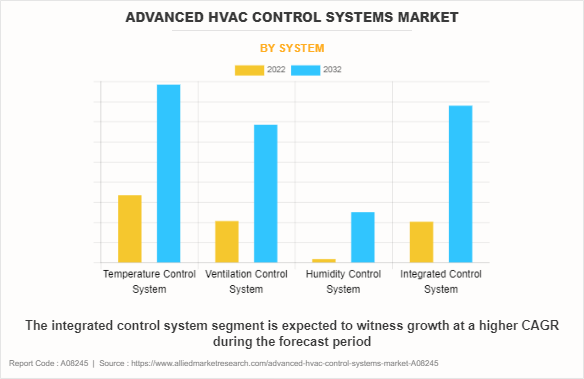
By System:
The advanced HVAC control systems market is divided into temperature control systems, ventilation control systems, humidity control systems, and integrated control systems. In 2022, the temperature control system segment dominated the advanced HVAC control systems market, in terms of revenue. The integrated control system segment is expected to dominate the advanced HVAC control systems market forecast by growing with the highest CAGR during the forecast period. Temperature control systems are used for heating or cooling a space, mostly, in cold and warm countries in North America, Europe, and Asia-Pacific. The high rate of construction in Asia-Pacific is a major driver of the advanced HVAC control systems market. On the other hand, increase in disposable income of people in general is enabling them to adopt advanced HVAC systems that can control all the environmental variables through a single control system.
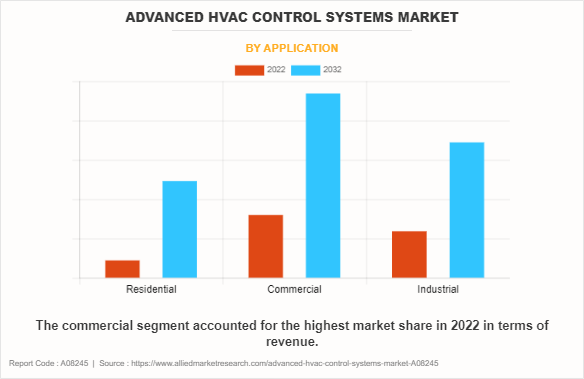
By Application:
The advanced HVAC control systems market is divided into residential, commercial, and industrial. The commercial segment accounted for the highest market share in 2022, owing to the growing urban population, which drives the demand for commercial buildings. However, the residential segment is anticipated to register a higher growth rate during the forecast period, owing to rise in demand for smart home systems which also includes advanced HVAC control systems.
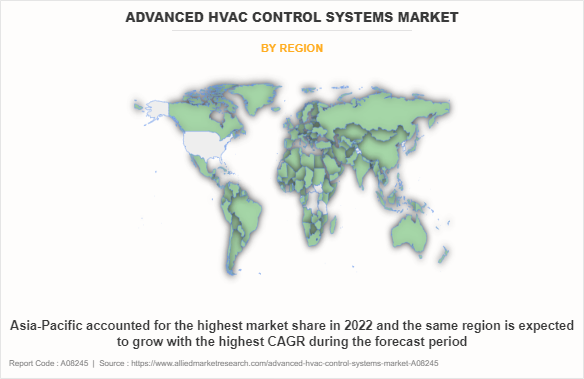
By Region:
Asia-Pacific accounted for the highest market share in 2022 and the same region is expected to grow with the highest CAGR during the forecast period. Asia-Pacific is a highly developing region with the fastest-growing population. According to the United Nations, nearly two-thirds of the world population resides in Asia-Pacific, with China and India alone accounting for one-third of the global population. In addition, the rate of urbanization in Asia-Pacific is also high. Thus, owing to high population growth and urbanization in the region, the construction sector witnessed a rapid rise, thereby, demand for advanced HVAC control systems, which are extensively used in these sectors is anticipated to rise in the coming years.
Competition Analysis
Competitive analysis and profiles of the major players in the advanced HVAC control systems market are provided in the report. Major companies in the report include Carrier Global Corporation, Danfoss A/S, Lennox International Inc., Honeywell International Inc., Johnson Control, Schneider Electric SE, Siemens AG, Daikin Industries, OJ Electronics A/S, and Ecobee Inc. Major players to remain competitive adopt development strategies such as product launches, business expansion, acquisitions, expansion, partnerships, and mergers.
For instance, in August 2023, Carrier has released its latest i-Vu® Express building automation device. Along with various other capabilities, the i-Vu building automation system is a user-friendly system, allowing facilities staff to manage the HVAC equipment in their building from anywhere in the world using any web-enabled device. Similarly, in March 2021, Siemens Smart Infrastructure introduced the new KNX Touch Control TC5 room operator unit. It makes passive buildings adaptive, consequently boosting the evolution of smart building technologies. The new room controller covers virtually all applications in the room, such as switching, dimming, color, and color temperature control, as well as shading and HVAC operation, including ventilation and air conditioning.
Key Benefits for Stakeholders
- The report provides an extensive analysis of the current and emerging advanced HVAC control systems market trends.
- In-depth advanced HVAC control systems market analysis is conducted by constructing market estimations for key market segments between 2022 and 2032.
- Extensive analysis of the advanced HVAC control systems market is conducted by following key product positioning and monitoring of top competitors within the market framework.
- A comprehensive analysis of all the regions is provided to determine the prevailing opportunities.
- The advanced HVAC control systems market revenue and volume forecast analysis from 2023 to 2032 are included in the report.
- The key players within the advanced HVAC control systems market are profiled in this report and their strategies are analyzed thoroughly, which helps understand the competitive outlook of the advanced HVAC control systems industry.
Advanced HVAC Control Systems Market Report Highlights
| Aspects | Details |
| Market Size By 2032 | USD 6.8 billion |
| Growth Rate | CAGR of 8.3% |
| Forecast period | 2022 - 2032 |
| Report Pages | 198 |
| By Installation Type |
|
| By System |
|
| By Application |
|
| By Region |
|
| Key Market Players | Honeywell International Inc., Ecobee Inc., OJ Electronics A/S, Danfoss A/S, Siemens AG, johnson control, Schneider Electric SE, Carrier Global Corporation, Lennox International Inc., Daikin Industries, Ltd. |
Analyst Review
The advanced HVAC control systems market has witnessed significant growth in the past few years, owing to an increase in construction activities, a rise in industrialization, and an increase in the popularity of sustainable development.
An advanced HVAC control system is a relatively new method of controlling HVAC operations. Thus, it has been witnessed, that people in developed countries such as the U.S., Germany, the UK, France, and others spend significantly on this new technology. Moreover, In Asia-Pacific, the revenue generated by the market in 2022 was higher than in other regions owing to its large population with a considerable disposable income. India, a highly populated country that is expected to witness the highest economic growth in the coming years is expected to present major growth opportunities in the coming years.
The global advanced HVAC control systems market is a well-consolidated market, having a few major manufacturers that hold a large share of the market. Furthermore, the demand for advanced HVAC control systems is anticipated to increase with the introduction of new technologies.
Development of the building construction market, the growing trend for sustainable development, and the rise in demand for building automation systems (BASs) drive the growth of the global advanced HVAC control systems market.
The latest version of the global advanced HVAC control systems market report can be obtained on demand from the website.
The global advanced HVAC control systems market size was valued at $3.1 billion in 2022.
The global advanced HVAC control systems market size is estimated to reach $6.7 billion by 2032, exhibiting a CAGR of 8.3% from 2023 to 2032.
The forecast period considered for the global advanced HVAC control systems market is 2023 to 2032, wherein, 2022 is the base year, 2023 is the estimated year, and 2032 is the forecast year.
Asia-Pacific is the largest regional market for advanced HVAC control systems market.
Key companies profiled in the advanced HVAC control systems market report include Carrier Global Corporation, Danfoss A/S, Lennox International Inc., Honeywell International Inc., Johnson Control, Schneider Electric SE, Siemens AG, Daikin Industries, OJ Electronics A/S, and Ecobee Inc.
The report contains an exclusive company profile section, where leading companies in the market are profiled. These profiles typically cover company overview, geographical presence, market dominance (in terms of revenue and volume sales), various strategies, and recent developments.
Loading Table Of Content...
Loading Research Methodology...



